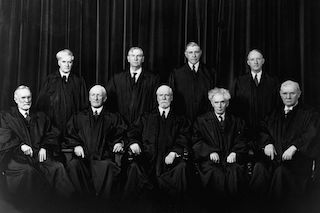Welcome to Lone Dissent, a website dedicated to some of the loneliest work that U.S. Supreme Court Justices have been engaging in for centuries: dissents. And not just any dissents, but lone dissents.
Yes, we’re talking about those cases where just one Justice could not be persuaded by their colleagues and who instead chose to write a dissent, explaining why he or she was absolutely right and all of their fellow Justices were absolutely wrong.
For example, Plessy v. Ferguson upheld the “separate but equal” treatment of black Americans in 1896. Justice John Marshall Harlan, the lone dissenter, wrote:
“Our Constitution is color-blind and neither knows nor tolerates classes among citizens. In respect of civil rights, all citizens are equal before the law. The humblest is the peer of the most powerful. The law regards man as man and takes no account of his surroundings or of his color when his civil rights as guaranteed by the supreme law of the land are involved… If evils will result from the commingling of the two races upon public highways established for the benefit of all, they will be infinitely less than those that will surely come from state legislation regulating the enjoyment of civil rights upon the basis of race.”
And in 1940, there was Minersville School District v. Gobitis, which involved two students who were expelled from a Pennsylvania public school for refusing to salute the flag as part of a daily school exercise. Justice Harlan Stone was the lone dissenter in that case, writing that the “very essence of the liberty” guaranteed by the Constitution “is the freedom of the individual from compulsion as to what he shall think and what he shall say.”
What’s striking about both of those dissents is that they eventually became the majority view. Plessy was effectively overruled by Brown v. Board of Education 58 years later, and Minersville was explicitly overruled only 3 years later, by West Virginia State Board of Education v. Barnette.
However, the vast majority of dissents never amount to much. They do get published and memorialized in the U.S. Reports alongside the majority opinions, providing a permanent record of winners and losers. But which ones are really worth revisiting, and why is it so hard for us to differentiate the prescient dissents from, say, the stubborn tirades?
Who knows. All we do know is that if we never take the time to revisit those dissents and make an effort to understand their arguments, we’ll never know.
